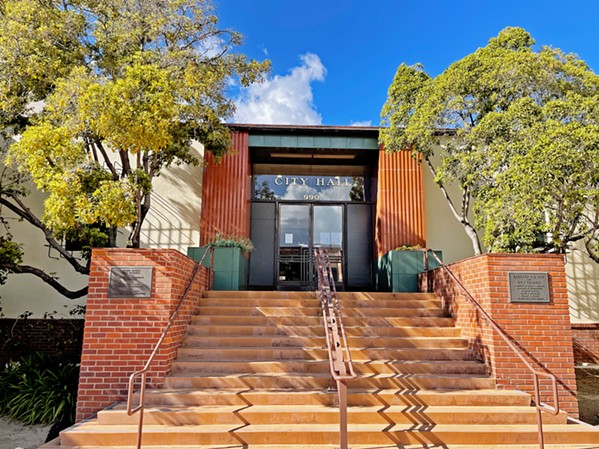[{
"name": "Ad - Medium Rectangle CC01 - 300x250",
"id": "AdMediumRectangleCC01300x250",
"class": "inlineCenter",
"insertPoint": "8",
"component": "2963441",
"requiredCountToDisplay": "12"
},{
"name": "Ad - Medium Rectangle LC01 - 300x250",
"id": "AdMediumRectangleCC01300x250",
"class": "inlineCenter",
"insertPoint": "18",
"component": "2963441",
"requiredCountToDisplay": "22"
},{
"name": "Ad - Medium Rectangle LC09 - 300x250",
"id": "AdMediumRectangleLC09300x250",
"class": "inlineCenter",
"insertPoint": "28",
"component": "3252660",
"requiredCountToDisplay": "32"
}]
More than two years after being told its election model violates the California Voting Rights Act, the city of San Luis Obispo continues to push back against the allegation—which has caused dozens of cities across the state, including three in SLO County, to adopt by-district election models for their city councils in recent years.
In the latest development, SLO officials said they recently agreed on another time extension with Santa Barbara-based attorney Robert Goodman to stave off a Voting Rights Act lawsuit—through May 10.
"We've entered into a series of extensions on the demand," SLO City Attorney Christine Dietrick told New Times. "We've been largely awaiting some additional data we have not yet received. ... Our analysis of the data and the facts about the composition of our community don't support that the district remedy is a tool well-fitted to advancing our community's goals."
SLO first received a "notice of violation" regarding its election model in November 2019. In the notice, Goodman, representing city resident Jamie Gomez, claimed that SLO's at-large election system "impairs the ability of protected classes to elect candidates of their choice and their ability to influence the outcome of elections."
The notice mirrored many others that have been sent out to cities with at-large election models across the state.
"District elections are sweeping California," Goodman's letter read. "As far as this office is aware, no government agency in California has successfully defended a complaint alleging violation of the California Voting Rights Act."
Facing costly lawsuits, with a low chance of success in court, other cities, including Arroyo Grande, Paso Robles, and Grover Beach, capitulated to the threat—and are now in the final stages of adopting new district maps for their councils ahead of the 2022 elections.
But SLO city hasn't budged. Dietrick explained that city leaders don't think that by-district elections in SLO could meaningfully improve minority representation or influence on the City Council.
"We've looked at the most recent census data and reevaluated whether or not in light of that census data and the demographics in our community, it's possible to even construct a district that's minority-majority or minority influenced," Dietrick said. "Our conclusion is that it's not possible to do that.
"We're fully supportive of the objective of advancing equity," she added. "It's just a question of, is this the right tool to advance those objectives in the context of the facts on the ground here."
Goodman could not be reached before press time, but in his 2019 violation notice, he argued that splitting the city into geographic districts is a proven remedy to achieving more diverse representation. He asserted that while close to 30 percent of SLO's population is non-white, only 10.7 percent of candidates for City Council since 2000 have come from a protected class—and those candidates received only 9.3 percent of votes.
"District elections bring government closer to the people," Goodman wrote. "There is a wider spectrum of views on the City Council and more representation from all neighborhoods and the entire community. District elections lead to greater neighborhood identity and have been accompanied by greater diversity of all sorts on elective bodies."
Looking ahead in the negotiations, Dietrick said that the California Supreme Court is expected to rule soon on a potentially precedent-setting case involving the city of Santa Monica and a neighborhood association, which sued the city to enact a by-district election model.
"[Santa Monica's] demographics and the nature of the arguments they're making are potentially very relevant," Dietrick said. "We're hopeful the Supreme Court will issue that guidance."
And as to why SLO is taking a different tack than other cities in SLO County when facing litigation under the Voting Rights Act, Dietrick said it boils down to dollars and cents.
"I think what happens with a lot of cities is they look at the defense numbers for cities who fought it, and it ranges from the hundreds of thousands to tens of millions [of dollars], and that's pretty daunting," Dietrick said. "I think the inclination is often to avail yourself of the safe harbor.
"It's not how we like to spend money," she added. "But also, our council is really committed to advancing our diversity, equity, and inclusion major city goal in meaningful ways for the community." Δ
Latest in News
Comments
Showing 1-1 of 1
Readers also liked…
-

Coast Unified teachers upset over new position's salary and qualifications
Oct 20, 2022 -

SLO police identify alleged driver who hit and killed couple
Dec 22, 2022 -

When the levee breaks: Oceano residents, county officials walk a tightrope of regulations to manage Arroyo Grande Creek, which some say led to the levee's failure in January
May 18, 2023










